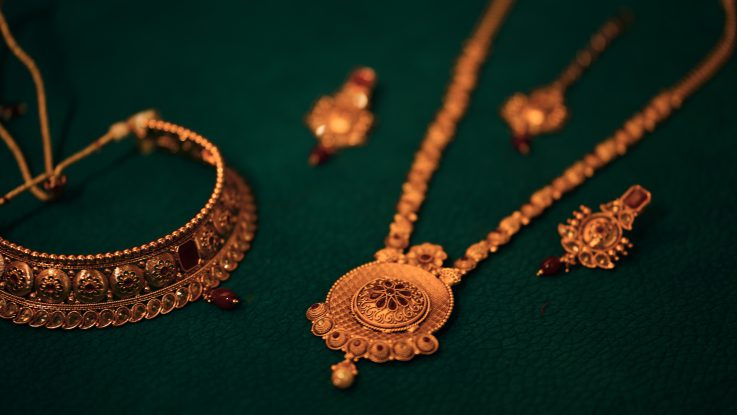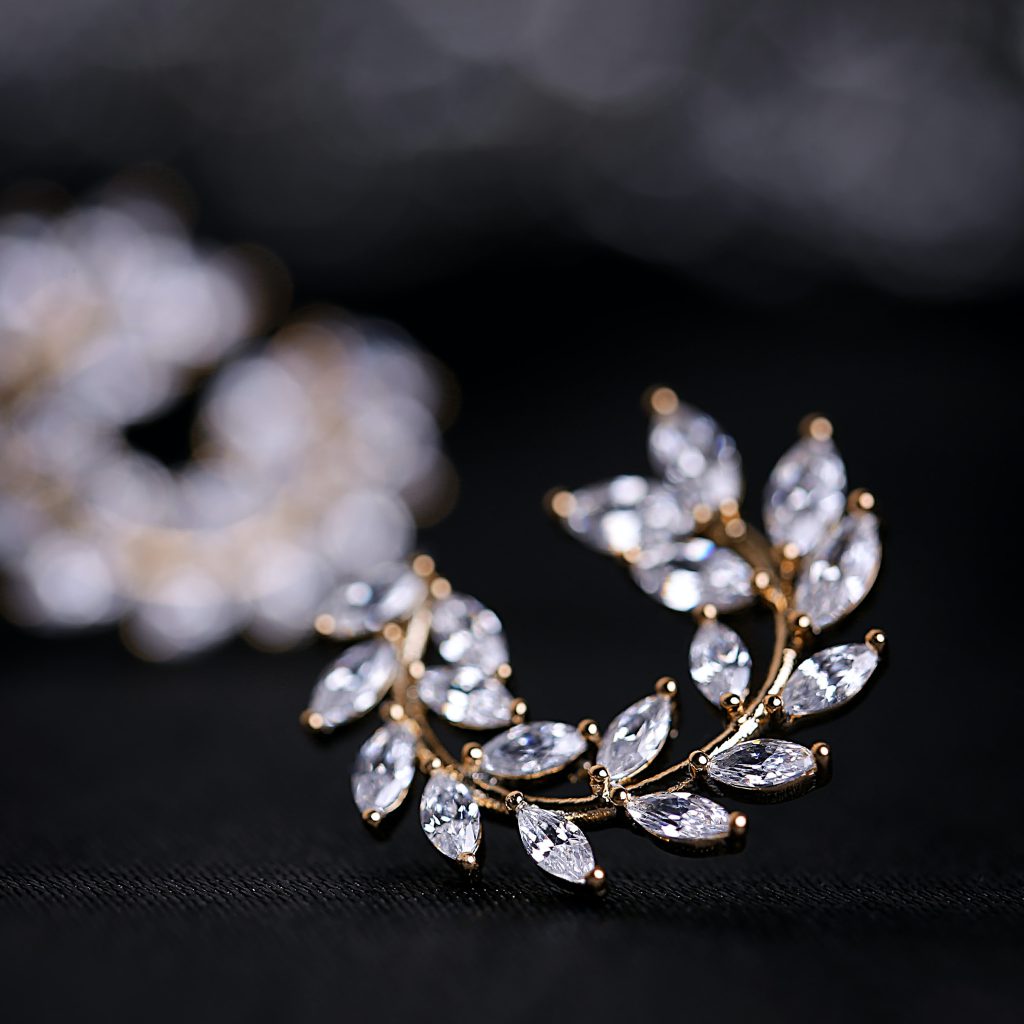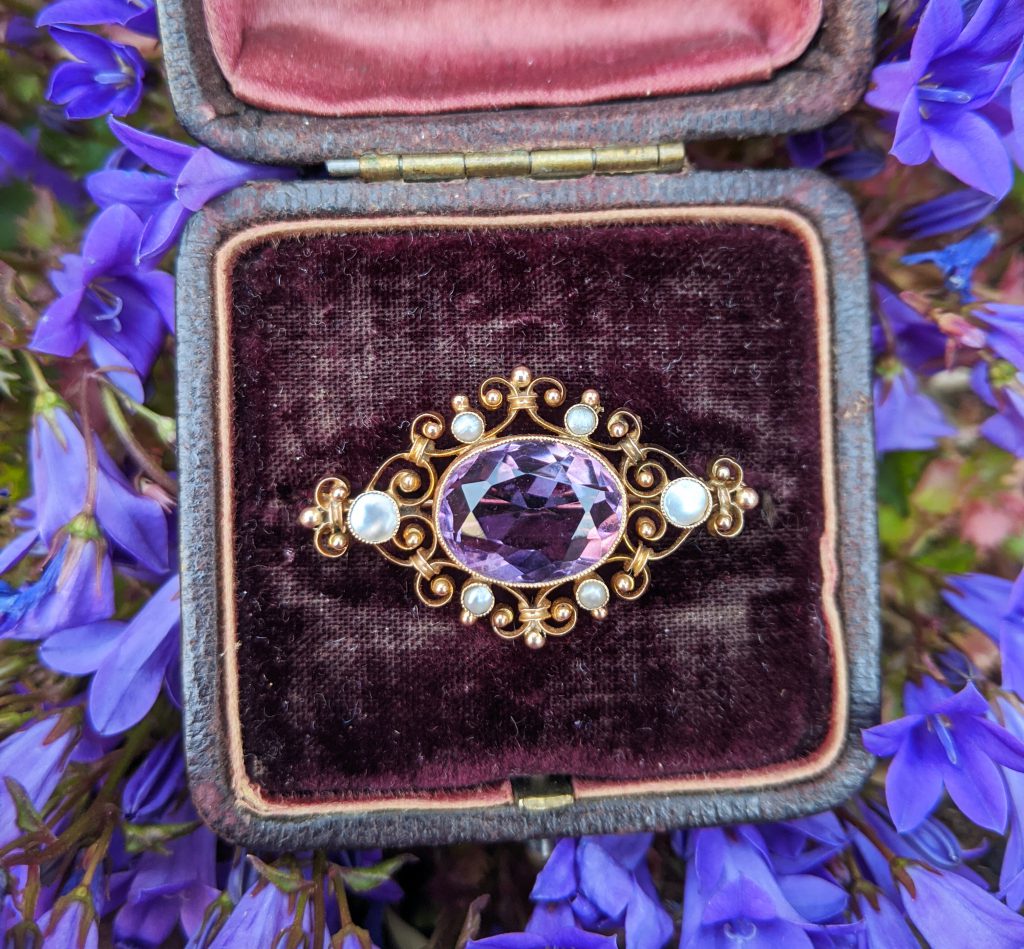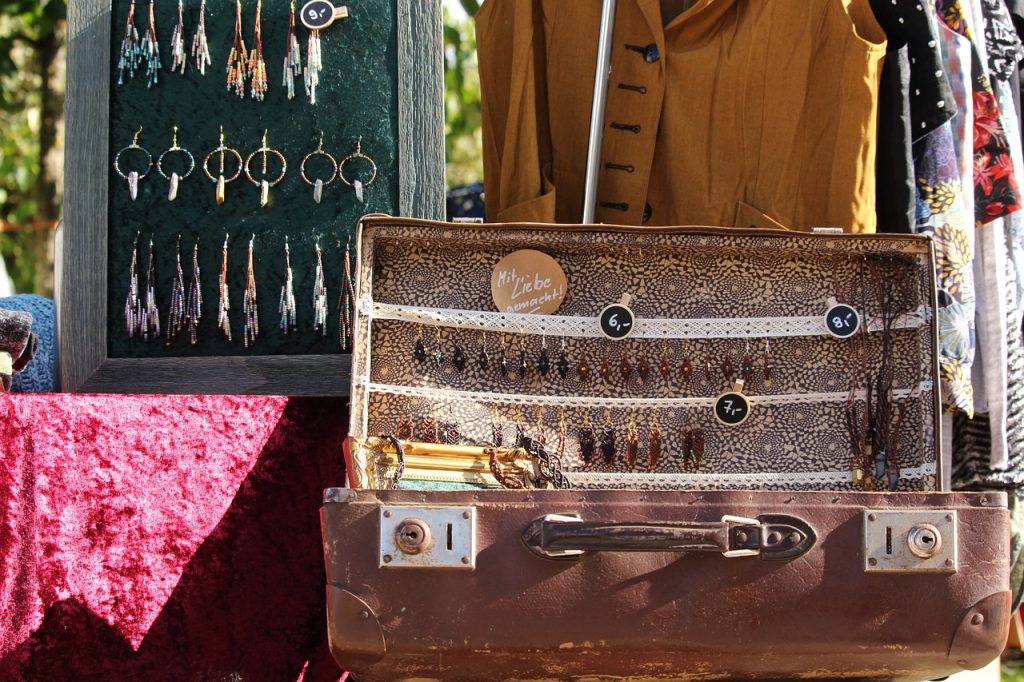
Ready to add a touch of history and uniqueness to your jewelry collection? Antique jewelry is the way to go!
In case you’re unsure, antique or vintage jewelry is any piece that’s at least 100 years old. Typically, these pieces represent very specific historical periods through their distinct styles.
Investing in vintage jewelry means owning a one-of-a-kind item that you cannot find anywhere else. Not to mention, antique jewelry is an eco-friendly choice since it doesn’t contribute to the environmental impact of modern jewelry manufacturing.
Antique jewelry includes not only necklaces and bracelets but also engagement rings passed down for generations. Adding an antique engagement ring to your collection gives a sentimental touch to one of the most cherished pieces of jewelry you’ll ever own. Art Deco diamond rings are among the most popular styles of antique engagement rings, with their intricate and geometric designs that will turn heads.
So, let’s see where to buy antique jewelry and get some tips for informed purchases! Many options are available, from strolling through antique shops to perusing online retailers catering to any budget or preference.
Get ready to infuse some character and history into your jewelry box with antique jewelry.
Popular Antique Retailers

Online retailers like EraGem and Estate Diamond Jewelry have made buying antique pieces more accessible than ever before. Their vintage and antique jewelry collection includes engagement rings, wedding rings, vintage rings, and estate jewelry. Both companies specialize in high-quality engagement ring pieces that are hard to find anywhere else.
In addition, they both sell jewelry directly through their online stores, meaning they’re direct sellers. Unlike a marketplace, these companies do not allow individuals to list their antique jewelry for sale.
Only high-quality and authentic antique jewelry pieces are sold in their collection. So, before adding a new piece, experienced jewelers check it for quality and authenticity.
Nevertheless, purchasing antique jewelry online requires knowledge about the item’s value and authenticity. Here are some things to keep in mind.
Do Your Research
Before purchasing your vintage jewelry, research the retailer you’re buying from. Look for customer reviews and ratings to gauge their reputation. Also, check if they are members of any professional associations like the Better Business Bureau, the International Antique Jewelry Association (IAJA), or the National Association of Jewelry Appraisers (NAJA) to confirm their credibility.
For instance, EraGem and Estate Diamond Jewelry both have an A+ rating on Better Business Bureau.
Consider the Condition

Antique jewelry is often sold in “as-is” condition, meaning it may have some wear and tear due to age. It’s important to carefully inspect the piece’s condition to determine its value. Examine the seller’s pictures closely and ask for additional images. If you’re unsure about the condition, ask the seller for their opinion.
Both Estate Diamond Jewelry and EraGem extensively describe the condition of each piece they sell. They provide detailed information about any visible flaws or wear and tear, along with high-resolution photographs that allow customers to examine each piece up close.
The companies also have a team of experienced jewelers who examine each piece to ensure its quality and authenticity before adding it to their collection. Consequently, many rings on that site appear brand new since professionals carefully choose them.
Look for a Guarantee
Some online antique retailers guarantee authenticity and quality for their antique pieces, which is reassuring, especially if you’re not an expert in antique jewelry. Look for a retailer with a money-back guarantee or return policy in case you’re dissatisfied with your purchase. Additionally, inquire about any warranties or guarantees that should come with the piece.
Estate Diamond Jewelry offers a 14-day no-questions-asked return policy, while EraGem provides a 60-day return policy with a 100% money guarantee.
Sizing Matters
Antique jewelry may not be sized the same way as modern pieces. So, knowing your finger, wrist, or neck size is crucial before buying antique jewelry. Many online retailers provide sizing charts or guides to help you determine the correct size. If unsure, consult a local jeweler to have it sized correctly.
You can reach Estate Diamond Jewelry and EraGem by phone with questions about the sizing of the rings and other jewelry on their websites.
Online Auction Sites

Online auction sites have become increasingly popular among antique jewelry enthusiasts, providing a thrilling and interactive platform to discover and acquire unique and valuable antique jewelry online. Some of the most famous auction sites include Christie’s, Bonhams, and Sotheby’s.
Navigating these digital auction houses can be both exciting and challenging, especially for newcomers. So here are some tips to get you started.
Familiarize Yourself with the Auction Process
Understanding the mechanics of online auctions is crucial to ensure a seamless and successful bidding experience. For instance, it’s essential to thoroughly review the auction sites’ terms and conditions, including bidding increments, buyer’s premium, and payment methods.
The buyer’s premium is an additional charge for successful bidders. For example, at Christie’s auction, the buyer’s premium is calculated based on the auction price of each piece. The current rate for the buyer’s premium stands at 26% of the auction price.
Be aware of any registration requirements or fees, as some auction sites may have specific guidelines for participation. Learn about the various bidding options available, such as absentee bidding, live bidding, or telephone bidding, to determine the best method for your needs.
To bid at Christie’s, you must first create an account and register for sales through your online account via their auction calendar. For identity verification, private individuals need to provide a copy of their government-issued photo ID and proof of residential address dated within the last three months, while organizations must submit relevant incorporation documents, business address information, directors, shareholders, ultimate beneficial owners, and authorized individuals’ government-issued photo IDs.
Christie’s offers multiple bidding options, such as in-person, online, telephone, and absentee bidding. For online auctions, you can browse, bid, and buy exclusively online during a fixed period. Although you must register your credit card information, your card will not be automatically charged upon winning. Instead, you’ll receive a link to pay online. The “Estimated Cost Calculator” on the lot page helps you determine the costs associated with each lot.
Research the Auction House and Listings
Invest time researching the auction house and the antique pieces listed to make informed decisions. Investigate the auction house’s reputation, expertise, and history to ensure a reliable and trustworthy experience.
Carefully examine the item listings, paying attention to descriptions, photographs, and any available documentation, such as provenance or certificates of authenticity. Conduct independent research on comparable items and their market values to help you determine a fair bidding range.
Set a Budget and Stick to It
Bidding wars can be exhilarating, but it’s essential to establish a budget and adhere to it to avoid overspending. Determine a maximum bid based on your research, personal valuation of the item, and financial considerations.
Resist the urge to get caught up in the excitement of the bidding process, and be prepared to walk away if it surpasses your limit. When setting your budget, factor in additional costs, such as buyer’s premium, shipping, insurance, and taxes.
Inspect and Verify the Jewelry
While online auction sites may provide photographs and descriptions, verifying the authenticity and condition of the antique jewelry is crucial. Request additional pictures, videos, or condition reports to ensure a comprehensive knowledge of the item.
Consult an expert or appraiser to validate the piece’s authenticity, value, and condition. If possible, attend a preview or exhibition event where the jewelry is available for an in-person inspection.
For example, Christie’s typically allows in-person viewing of items before an auction. They often organize exhibitions and private viewings for potential buyers to inspect the items up close and better understand their condition, quality, and details.
Prepare for Post-Auction Logistics
Once the auction is over, it’s essential to prepare for the logistics of finalizing your purchase and receiving your antique jewelry. Understand the auction house’s payment terms, including accepted methods and any applicable deadlines.
Inquire about shipping options, insurance, and tracking information to ensure your item arrives safely and promptly. Retain all documentation, including invoices, receipts, and certificates of authenticity, as these materials may be necessary for insurance, resale, or provenance purposes.
To illustrate this, let’s take Christie as an example again. When you successfully win an item at their auction, either online-only or live, you can access your invoice and choose shipping options through your online account. Christie’s accepts major credit and debit cards, with certain limits based on the currency. For larger purchases, bank transfers are recommended.
Also, be aware that a 2% administration fee may apply for credit card transactions at New York auctions. The Post-Sale Services team is always ready to help if needed.
After a live auction, clients will receive an email from Christie’s post-sale services, which includes an invoice detailing the price, buyer’s premium, taxes, and any other applicable charges like resale royalties when required.
For online-only auctions, buyers will receive an email guiding them to the online checkout page, where they’ll see an itemized list of costs, such as the buyer’s premium, shipping, taxes, and insurance. You should give a payment confirmation once the payment is processed.
Payments for live auctions are due within seven days, while you must make online-only auction payments immediately via the online checkout.
eBay, Etsy, and Similar Marketplace Sites

Online marketplace platforms such as eBay and Etsy have become popular destinations for antique jewelry enthusiasts looking to discover unique, one-of-a-kind antique pieces. While these sites offer a vast selection and often competitive pricing, it’s always a good idea to know how to navigate these platforms, ensure authenticity, and secure the best deals.
Evaluating Seller Reputation
When purchasing antique jewelry on marketplace sites, it’s crucial to carefully examine the seller’s reputation, feedback, and history to ensure a positive buying experience. Search for vendors with a strong feedback score and a track record of favorable reviews, as these factors suggest a dependable and credible seller.
Examine positive and negative feedback to obtain a well-rounded perspective on the seller’s overall performance and client satisfaction. Determine whether the seller has a background in selling antique jewelry, which may indicate their familiarity and proficiency in this domain.
When evaluating a seller’s reputation on eBay, it’s essential to consider factors such as their feedback score and percentage, detailed seller ratings (DSRs), and the seller’s history. A reputable seller typically has a high feedback score (e.g., above 98%) and many positive reviews.
Furthermore, examining the seller’s DSRs offers insights into specific aspects of their performance, including item description accuracy, communication, shipping time, and shipping charges. Ideally, DSRs should be close to or at 5.0. Assessing the seller’s history, such as when they have been active on eBay and their consistently positive feedback record, can also help determine their trustworthiness.
If you’re evaluating the reputation of a seller on Etsy, be sure to examine various aspects, such as seller reviews, the shop’s “About” section, and the shop’s age and sales. Analyzing the seller’s reviews from past buyers reveals patterns in feedback, like consistently positive comments regarding product quality, shipping time, and customer service. Generally, a higher average star rating (e.g., 4.5 or above) indicates a trustworthy seller.
Additionally, the “About” features insights into the seller’s background, experience, and the story behind their products, which helps gauge their dedication and professionalism.
Assessing the Listing
To confidently make the best choice, dive deep into the listing, immersing yourself in the intricacies of the description, captivating images, and any documentation available. Then, attentively review the item description, focusing on specifics regarding the piece’s age, composition, state, and history.
Examine the images meticulously and, if needed, ask for more photos or video clips to understand the item’s aesthetics and condition better. Look for documentation, such as a certificate of authenticity, to verify the piece’s origin, age, and materials.
Secure Payment and Shipping
To protect yourself from potential fraud and ensure a smooth transaction, utilize secure payment methods such as PayPal, which offers buyer protection in case of disputes or issues with the purchase.
Both eBay and Etsy accept PayPal as a payment method. In addition to this, they also accept credit and debit cards, Apple Pay, and Google Pay.
Inquire about the shipping process, including the shipping method, insurance, tracking information, and estimated delivery time. Be prepared for potential customs fees or import taxes if purchasing from an international seller, as sellers may not include these costs in the item’s price or shipping fees.
Asking Questions and Communicating with the Seller
Maintaining open communication with the seller is a big part of the purchasing process of antique jewelry on marketplace sites. Don’t hesitate to ask the seller questions about the item, including any concerns or additional information you may require to make an informed decision.
If you’re unsure about any aspect of the listing, consult an expert or conduct independent research before committing to a purchase. Be courteous and professional in your communications, as this can foster a positive relationship with them and potentially lead to future transactions or referrals.
Know Your Rights and Return Policies
Understanding your rights as a buyer and the seller’s return policy will ensure a positive buying experience and protect you in case of any issues. Familiarize yourself with the marketplace platform’s buyer protection policies, as these provide recourse in case of disputes or problems with the purchase.
Also, review the individual seller’s return policy, including any time limits, fees, or conditions associated with returns or exchanges. Finally, keep all documentation, including receipts, shipping information, and any correspondence with the seller, in case you need to reference these materials for returns or disputes.
Etsy allows sellers to set their own return policies, including whether or not they accept returns, offer exchanges, or provide refunds. Buyers should review each seller’s return policy before making a purchase. If a buyer encounters an issue with their order, such as not receiving the item or receiving an item that doesn’t match the description, they can open a case with Etsy. The platform will then mediate between the buyer and the seller to resolve the issue.
Like Etsy, eBay allows sellers to set their return policies. Some sellers may offer hassle-free returns, while others may have more restrictive policies. Because of this, buyers need to review each seller’s return policy before purchasing an item. Still, there’s some protection in place. eBay offers a money-back guarantee for buyers who don’t receive their item or receive an item that doesn’t match the description. If the buyer and seller can’t reach an agreement, eBay may step in to resolve the issue and potentially refund the buyer.
Etsy and eBay both charge sellers various fees for listing and selling items on their platforms. However, they don’t generally charge fees specifically related to returns. The individual seller’s policy often determines the cost of return shipping, and in some cases, the buyer may be responsible for covering return shipping costs.
Antique and Vintage Shops

Antique and vintage shops provide a unique opportunity to explore a curated collection of antique jewelry, often accompanied by knowledgeable staff who offer insights into each piece’s history and craftsmanship. So whether you’re searching for an art deco diamond, engagement ring, or vintage jewelry, they’re always here to assist you with everything you need.
While these shops can be a collector’s treasure trove, you need to know what to look for and how to ensure you’re making a wise investment.
There are many famous physical antique shops across the United States. A few famous ones include Doyle & Doyle (New York City), The Antique Gallery of Houston (Houston), and Platt Boutique Jewelry (Los Angeles).
Finding Reputable Antique and Vintage Shops
The first step in purchasing antique jewelry from antique and vintage shops is identifying reputable establishments with a proven track record for quality and authenticity. Seek recommendations from friends, family, or online reviews to find trustworthy shops near you. You can check a store’s reputation by going through its Google reviews. For example, the Antique Gallery of Houston is rated 4.6 with excellent comments from almost 700 reviews.
Visit local antique fairs, exhibitions, or events where these shops might have a booth, offering additional inventory not available in-store. Look for shops specializing in antique jewelry or have a dedicated section for these items.
Verifying Authenticity and Quality
Ensuring the piece’s authenticity and quality is crucial when purchasing jewelry from antique and vintage shops. Request documentation, such as a certificate of authenticity, to verify the piece’s age, materials, and provenance.
Inspect the jewelry closely for hallmarks, signatures, or other indicators of authenticity. Next, examine the piece for signs of quality craftsmanship, including intricate detailing, secure settings, and well-executed designs.
Consult with Knowledgeable Staff
One of the advantages of buying antique jewelry from antique and vintage shops is the presence of knowledgeable staff who provide valuable insights and guidance. Don’t hesitate to ask questions about the piece’s history, craftsmanship, or materials, as the staff may have helpful information unavailable through a simple visual inspection.
Seek advice on caring for and maintaining the piece to ensure its longevity and preserve its value. Inquire about any available services, such as resizing, cleaning, or repair, which the shop may offer.
Negotiating Price
Antique and vintage shops may offer more flexibility in their pricing, allowing negotiation to secure a more favorable deal. Approach negotiations with a friendly and respectful attitude, as shop owners may be more willing to compromise with a pleasant buyer.
Research comparable items and their market prices to inform your negotiation and ensure you make a fair offer. Be prepared to walk away if the seller is unwilling to negotiate or the price remains too high.
The best way to determine whether the shop will negotiate the price is by asking the staff in person. However, in some shops, the owner states explicitly that they don’t accept negotiations, such as the case with Doyle & Doyle.
Understanding Return and Exchange Policies
Before making a purchase, it’s necessary to familiarize yourself with the shop’s return and exchange policies. Inquire about the shop’s return policy, including any associated fees, time limits, or conditions.
Understand the difference between store credit, exchanges, and refunds, as shops may have varying policies regarding each option. Keep your receipt and any associated documentation, as these may be required for returns or exchanges.
For example, Platt Boutique Jewelry offers a full refund for returns made within 7 days of purchase, but you must have your receipt with you.
Estate and Garage Sales

Estate and garage sales offer unique opportunities for antique jewelry enthusiasts to discover hidden gems and original pieces. Although these events are a goldmine for collectors, they often require patience, persistence, and a keen eye for detail.
Research and Preparation
Before embarking on your antique jewelry hunt, conducting thorough research is advisable to identify promising estate and garage sales in your area. Use websites like EstateSales.net or local classifieds to find upcoming sales with potential antique jewelry pieces.
Join local antique jewelry or estate sale groups on social media to stay informed about events and share tips with fellow enthusiasts. Create a plan for visiting multiple sales in a single day, prioritizing those with the highest potential for antique jewelry.
Arrive Early
To increase your chances of finding valuable pieces, arriving early at the estate and garage sales is necessary. Arrive at the sale’s opening time or earlier to ensure you’re among the first to browse the available items.
Be prepared to wait in line if necessary, as other collectors may also be eager to uncover hidden treasures. Dress comfortably and bring snacks, water, and a portable chair if you anticipate long waiting times.
Bring Essential Tools
When shopping for antique jewelry at estate and garage sales, having the right tools can significantly impact your ability to assess and identify valuable pieces. Bring a magnifying glass or jeweler’s loupe to inspect the jewelry closely, looking for hallmarks, signatures, or other indications of authenticity.
Carry a smartphone or tablet to research items or check current market prices quickly. Also, consider bringing a portable light source, such as a flashlight or headlamp, to ensure you can examine items in detail, even in dimly lit areas.
Develop a Keen Eye for Detail
Recognizing valuable antique jewelry among the vast array of estate and garage sales items requires a discerning eye and knowledge of different styles, materials, and time periods. Study various antique jewelry eras, such as Georgian, Victorian, Art Nouveau, and Art Deco, to familiarize yourself with their distinctive features and styles.
Learn to identify common materials and gemstones in antique jewelry, such as gold, silver, platinum, diamonds, and pearls. Examine pieces for signs of quality craftsmanship, including intricate detailing, secure settings, and well-executed designs.
Negotiate and Build Relationships
Estate and garage sales often provide the opportunity to negotiate prices, which can help you secure valuable antique jewelry at a more affordable cost. Approach negotiations with a friendly and respectful attitude, as sellers may be more willing to compromise with a pleasant buyer.
Build relationships with sellers who frequently offer antique jewelry, as they may inform you of future sales or offer special discounts.
Conclusion
Antique jewelry is an excellent way to add some history and character to your jewelry collection, whether you’re a first-time buyer or a seasoned collector. Plenty of options are available, ranging from traditional brick-and-mortar antique shops to the convenience of online retailers.
With some research and knowledge, you can discover the ideal piece that fits your style and budget. Whether you’re drawn to a stunning Art Deco engagement ring or a unique vintage bracelet, antique jewelry has something for everyone.
Grab your magnifying glass and put on your detective hat! It’s time to hunt for that perfect piece of antique jewelry that speaks to you and adds a timeless touch to your collection.

Leave a Reply